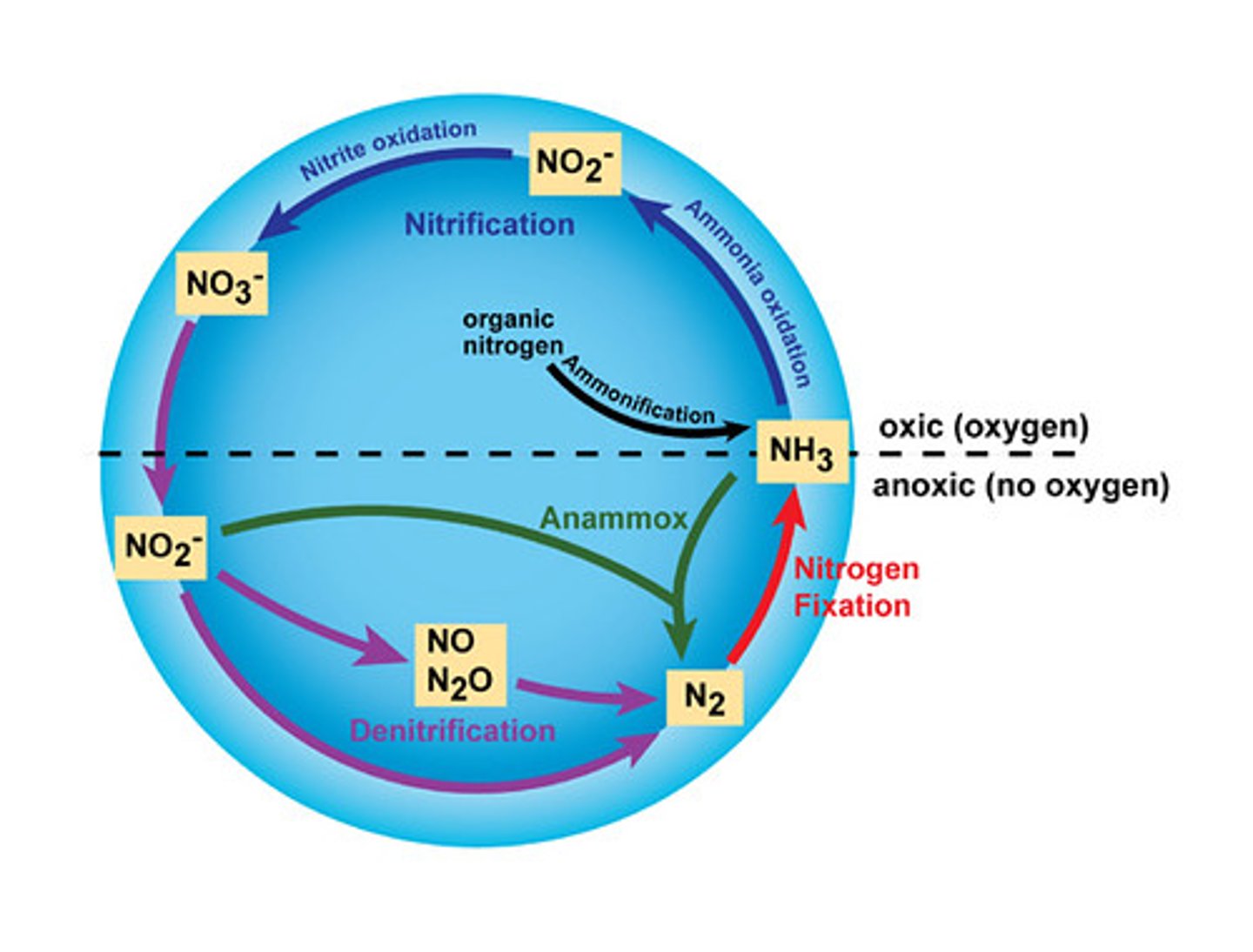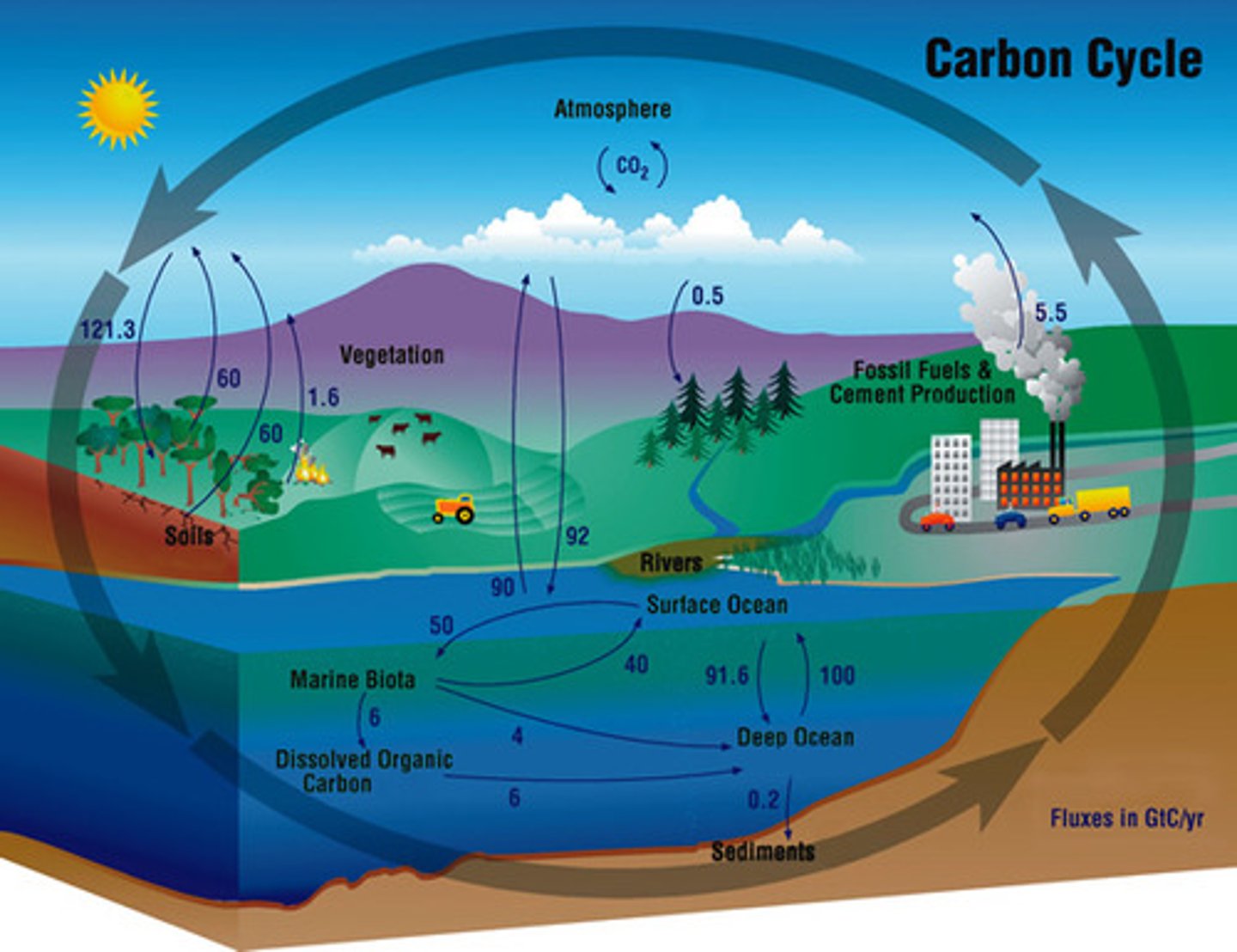Biogeochemical Cycles Quiz
1/52
There's no tags or description
Looks like no tags are added yet.
Name | Mastery | Learn | Test | Matching | Spaced |
|---|
No study sessions yet.
53 Terms
Runoff
The Hydrologic Cycle- water flowing down hill
Transpiraton
The Hydrologic Cycle- loss of excess water from land plants
Condensation
The Hydrologic Cycle- phase change from water vapor to liquid water
Infiltration
The Hydrologic Cycle- water filtering through the pore spaces in soil or rock
Evaporation
The Hydrologic Cycle- phase change from liquid water to water vapor
Precipitation
The Hydrologic Cycle- rain, snow, sleet, or hail
Combustion
The Carbon Cycle- burning fossil fuels & other organic molecules
Burial and Combustion
The Carbon Cycle- dissolved CO2 in water is compacted into sediments to form rock (limestone)
Decomposition
The Carbon Cycle- organic materials breaks down, returning organic carbon to the soil
Photosynthesis
The Carbon Cycle- plants using CO2 & light energy to produce O2 & food
Erosion
The Carbon Cycle- breaking down & transporting solid materials (usually rocks/ soils)
Cellular Respiration
The Carbon Cycle- living organisms using O2 & food to produce CO2 & energy
Excretion
The Nitrogen Cycle- animal waste return organic nitrogen to the soil
Ammonification
The Nitrogen Cycle- bacteria convert organic nitrogen into ammonia during decomposition
Denitrification
The Nitrogen Cycle- bacteria convert nitrates to atmospheric nitrogen
Assimilation
The Nitrogen Cycle- plants absorb nitrates through their roots
Ingestion
The Nitrogen Cycle- animals eat plants and other organic materials containing nitrates
Nitrification
The Nitrogen Cycle- bacteria convert ammonia or ammonium into nitrates
Nitrogen Fixation
The Nitrogen Cycle- bacteria or legumes convert atmospheric nitrogen into the more usable ammonia
Erosion
The Phosphorous Cycle- rocks or soil are broken down, transporting phosphorous across land or in water
Excretion
The Phosphorous Cycle- animal waste returns organic phosphorous to the soil
Phosphate Mining
The Phosphorous Cycle- humans remove phosphates from underground for fertilizers
Absorption
The Phosphorous Cycle- plants absorb phosphates through their roots
Decompostion
The Phosphorous Cycle- organic material breaks down, returning organic phosphorous to the soil
Geologic Uplift
The Phosphorous Cycle- exposing underground rocks to the surface
Ingestion
The Phosphorous Cycle- Animals eat plants and other organic materials containing phosphates
Burial and Compaction
The Phosphorous Cycle- organisms are compacted into sediments to form rock
Sulfur Dioxide
The Sulfur Cycle- SO2- released by volcanic eruptions & fuel combustion, and formed from H2S reacting with oxygen
Decomposition
The Sulfur Cycle- organic material breaks down, returning organic sulfur to the soil
Bacteria Decay
The Sulfur Cycle- bacteria release H2S back to the atmospheric during decay
Sulfuric Acid
The Sulfur Cycle- H2SO4- formed from sulfur oxides reacting with water vapor
Hydrogen Sulfide
The Sulfur Cycle- H2S- released by volcanic eruptions, fuel combustion, and bacteria in soil
Dimethyl Sulfide
The Sulfur Cycle- DMS- released to the atmosphere by marine organisms & helps cloud droplets condense, and ultimately converts to SO2
Erosion
The Sulfur Cycle- rocks/ soils break down, transporting sulfur across land or in water
Deposition
The Sulfur Cycle- sulfur settles back to Earth or comes down with precipitation
Infiltration
The Sulfur Cycle- sulfates filtering through pores in soil or rock
Combustion
The Sulfur Cycle- burning fossil fuels such as coal and oil
Absorption
The Sulfur Cycle- sulfates taken up by plants through their roots
Sedimentary Rock
The Rock Cycle- formed when sediment compacted together
Sediment
The Rock Cycle- small particles of rock or soil
Compacting and Cementation
The Rock Cycle- forces that create sedimentary rock
Heat and Pressure
The Rock Cycle- forces that create metamorphic rock
Magma
The Rock Cycle- molten rock
Metamorphic Rock
The Rock Cycle- formed when other rocks that have undergone a significant change
Melting
The Rock Cycle- significant heating of rocks to create magma
Weathering and Erosion
The Rock Cycle- rocks break down and are transported away
Igneous Rock
The Rock Cycle- formed from cooled magma
Cooling and Hardening
The Rock Cycle- processes that create igneous rock
Nitrogen Cycle
The continuous sequence of events by which atmospheric nitrogen and nitrogenous compounds in the soil are converted, as by nitrification and nitrogen fixation, into substances that can be utilized by green plants, the substances returning to the air and soil as a result of the decay of the plants and denitrification and then made available to the nonliving environment

Carbon Cycle
Carbon is absorbed by producers such as plants, which give some carbon back to the atmosphere, then the decomposers break dead plants down, releasing more carbon into the atmosphere, and we breath in and out, taking in oxygen but also releasing carbon into the atmosphere through respiration.
Carbon is also released into the atmosphere by burning of fossil fuels.

Sulfur Cycle
Cyclic movement of sulfur in different chemical forms from the environment to organisms and then back to the environment. Human impacts include the burning of coal and the internal combustion engine, causing sulfuric acid to be emitted into the atmosphere, becoming another component of acid rain.
Phosphorus Cycle
Cycles through water, earth's crusts, and living organisms. The major reservoir is phosphate salts, and it is very slow. Humans affect it by removing large quantities of it to make fertilizers
Rock Cycle
A series of processes on the surface and inside Earth that slowly changes rocks from one kind to another